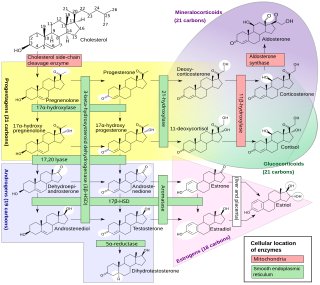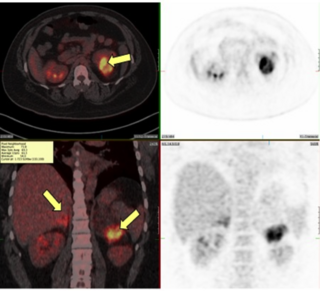Related Research Articles

The adrenal glands are endocrine glands that produce a variety of hormones including adrenaline and the steroids aldosterone and cortisol. They are found above the kidneys. Each gland has an outer cortex which produces steroid hormones and an inner medulla. The adrenal cortex itself is divided into three main zones: the zona glomerulosa, the zona fasciculata and the zona reticularis.

Dehydroepiandrosterone (DHEA), also known as androstenolone, is an endogenous steroid hormone precursor. It is one of the most abundant circulating steroids in humans. DHEA is produced in the adrenal glands, the gonads, and the brain. It functions as a metabolic intermediate in the biosynthesis of the androgen and estrogen sex steroids both in the gonads and in various other tissues. However, DHEA also has a variety of potential biological effects in its own right, binding to an array of nuclear and cell surface receptors, and acting as a neurosteroid and modulator of neurotrophic factor receptors.

An androgen is any natural or synthetic steroid hormone that regulates the development and maintenance of male characteristics in vertebrates by binding to androgen receptors. This includes the embryological development of the primary male sex organs, and the development of male secondary sex characteristics at puberty. Androgens are synthesized in the testes, the ovaries, and the adrenal glands.

Progestogens, also sometimes written progestagens or gestagens, are a class of natural or synthetic steroid hormones that bind to and activate the progesterone receptors (PR). Progesterone is the major and most important progestogen in the body. The progestogens are named for their function in maintaining pregnancy, although they are also present at other phases of the estrous and menstrual cycles.

The adrenal cortex is the outer region and also the largest part of the adrenal gland. It is divided into three separate zones: zona glomerulosa, zona fasciculata and zona reticularis. Each zone is responsible for producing specific hormones. It is also a secondary site of androgen synthesis.

Androstenedione, or 4-androstenedione, also known as androst-4-ene-3,17-dione, is an endogenous weak androgen steroid hormone and intermediate in the biosynthesis of estrone and of testosterone from dehydroepiandrosterone (DHEA). It is closely related to androstenediol (androst-5-ene-3β,17β-diol).

Congenital adrenal hyperplasia (CAH) is a group of autosomal recessive disorders characterized by impaired cortisol synthesis. It results from the deficiency of one of the five enzymes required for the synthesis of cortisol in the adrenal cortex. Most of these disorders involve excessive or deficient production of hormones such as glucocorticoids, mineralocorticoids, or sex steroids, and can alter development of primary or secondary sex characteristics in some affected infants, children, or adults. It is one of the most common autosomal recessive disorders in humans.

Adrenal insufficiency is a condition in which the adrenal glands do not produce adequate amounts of steroid hormones. The adrenal glands—also referred to as the adrenal cortex—normally secrete glucocorticoids, mineralocorticoids, and androgens. These hormones are important in regulating blood pressure, electrolytes, and metabolism as a whole. Deficiency of these hormones leads to symptoms ranging from abdominal pain, vomiting, muscle weakness and fatigue, low blood pressure, depression, mood and personality changes to organ failure and shock. Adrenal crisis may occur if a person having adrenal insufficiency experiences stresses, such as an accident, injury, surgery, or severe infection; this is a life-threatening medical condition resulting from severe deficiency of cortisol in the body. Death may quickly follow.

Lipoid congenital adrenal hyperplasia is an endocrine disorder that is an uncommon and potentially lethal form of congenital adrenal hyperplasia (CAH). It arises from defects in the earliest stages of steroid hormone synthesis: the transport of cholesterol into the mitochondria and the conversion of cholesterol to pregnenolone—the first step in the synthesis of all steroid hormones. Lipoid CAH causes mineralocorticoid deficiency in affected infants and children. Male infants are severely undervirilized causing their external genitalia to look feminine. The adrenals are large and filled with lipid globules derived from cholesterol.

Congenital adrenal hyperplasia due to 11β-hydroxylase deficiency is a form of congenital adrenal hyperplasia (CAH) which produces a higher than normal amount of androgen, resulting from a defect in the gene encoding the enzyme steroid 11β-hydroxylase (11β-OH) which mediates the final step of cortisol synthesis in the adrenal. 11β-OH CAH results in hypertension due to excessive mineralocorticoid effects. It also causes excessive androgen production both before and after birth and can virilize a genetically female fetus or a child of either sex.

Congenital adrenal hyperplasia due to 3β-hydroxysteroid dehydrogenase deficiency is an uncommon form of congenital adrenal hyperplasia (CAH) resulting from a mutation in the gene for one of the key enzymes in cortisol synthesis by the adrenal gland, 3β-hydroxysteroid dehydrogenase (3β-HSD) type II (HSD3B2). As a result, higher levels of 17α-hydroxypregnenolone appear in the blood with adrenocorticotropic hormone (ACTH) challenge, which stimulates adrenal corticosteroid synthesis.
Congenital adrenal hyperplasia due to 17α-hydroxylase deficiency is an uncommon form of congenital adrenal hyperplasia resulting from a defect in the gene CYP17A1, which encodes for the enzyme 17α-hydroxylase. It causes decreased synthesis of cortisol and sex steroids, with resulting increase in mineralocorticoid production. Thus, common symptoms include mild hypocortisolism, ambiguous genitalia in genetic males or failure of the ovaries to function at puberty in genetic females, and hypokalemic hypertension (respectively). However, partial (incomplete) deficiency is notable for having inconsistent symptoms between patients, and affected genetic (XX) females may be wholly asymptomatic except for infertility.
Adrenarche is an early stage in sexual maturation that happens in some higher primates and in humans, typically peaks at around 20 years of age, and is involved in the development of pubic hair, body odor, skin oiliness, axillary hair, sexual attraction/sexual desire/increased libido and mild acne. During adrenarche the adrenal glands secrete increased levels of weak adrenal androgens, including dehydroepiandrosterone (DHEA), dehydroepiandrosterone sulfate (DHEA-S), and androstenedione (A4), but without increased cortisol levels. Adrenarche is the result of the development of a new zone of the adrenal cortex, the zona reticularis. Adrenarche is a process related to puberty, but distinct from hypothalamic–pituitary–gonadal axis maturation and function.

Congenital adrenal hyperplasia due to 21-hydroxylase deficiency (CAH) is a genetic disorder characterized by impaired production of cortisol in the adrenal glands.

Hyperandrogenism is a medical condition characterized by high levels of androgens. It is more common in women than men. Symptoms of hyperandrogenism may include acne, seborrhea, hair loss on the scalp, increased body or facial hair, and infrequent or absent menstruation. Complications may include high blood cholesterol and diabetes. It occurs in approximately 5% of women of reproductive age.

Prasterone, also known as dehydroepiandrosterone (DHEA) and sold under the brand name Intrarosa among others, is a medication as well as over-the-counter dietary supplement which is used to correct DHEA deficiency due to adrenal insufficiency or old age, as a component of menopausal hormone therapy, to treat painful sexual intercourse due to vaginal atrophy, and to prepare the cervix for childbirth, among other uses. It is taken by mouth, by application to the skin, in through the vagina, or by injection into muscle.
In humans and other animals, the adrenocortical hormones are hormones produced by the adrenal cortex, the outer region of the adrenal gland. These polycyclic steroid hormones have a variety of roles that are crucial for the body’s response to stress, and they also regulate other functions in the body. Threats to homeostasis, such as injury, chemical imbalances, infection, or psychological stress, can initiate a stress response. Examples of adrenocortical hormones that are involved in the stress response are aldosterone and cortisol. These hormones also function in regulating the conservation of water by the kidneys and glucose metabolism, respectively.

Dehydroepiandrosterone sulfate, abbreviated as DHEA sulfate or DHEA-S, also known as androstenolone sulfate, is an endogenous androstane steroid that is produced by the adrenal cortex. It is the 3β-sulfate ester and a metabolite of dehydroepiandrosterone (DHEA) and circulates in far greater relative concentrations than DHEA. The steroid is hormonally inert and is instead an important neurosteroid and neurotrophin.
3β-Hydroxysteroid dehydrogenase/Δ5-4 isomerase (3β-HSD) is an enzyme that catalyzes the biosynthesis of the steroid progesterone from pregnenolone, 17α-hydroxyprogesterone from 17α-hydroxypregnenolone, and androstenedione from dehydroepiandrosterone (DHEA) in the adrenal gland. It is the only enzyme in the adrenal pathway of corticosteroid synthesis that is not a member of the cytochrome P450 family. It is also present in other steroid-producing tissues, including the ovary, testis and placenta. In humans, there are two 3β-HSD isozymes encoded by the HSD3B1 and HSD3B2 genes.

An inborn error of steroid metabolism is an inborn error of metabolism due to defects in steroid metabolism.
References
- 1 2 3 4 5 6 Soffer LJ, Gutman A, Geller J, Gabrilove JL (1957). "The role of adrenal steroids on renal function and electrolyte metabolism". Bulletin of the New York Academy of Medicine. 33 (10): 665–680. PMC 1806252 . PMID 13460566.
- 1 2 3 4 5 6 7 8 9 LIN-SU K, NEW MI (2007-11-01). "Effects of Adrenal Steroids on the Bone Metabolism of Children with Congenital Adrenal Hyperplasia". Annals of the New York Academy of Sciences. 1117 (1): 345–351. Bibcode:2007NYASA1117..345L. doi:10.1196/annals.1402.040. ISSN 0077-8923. PMID 18056052. S2CID 2869.
- 1 2 Marumudi E, Khadgawat R, Surana V, Shabir I, Joseph A, Ammini AC (August 2013). "Diagnosis and management of classical congenital adrenal hyperplasia". Steroids. 78 (8): 741–746. doi:10.1016/j.steroids.2013.04.007. ISSN 0039-128X. PMID 23624029. S2CID 3521421.
- 1 2 Antoniou-Tsigkos A, Zapanti E, Ghizzoni L, Mastorakos G (2000), Feingold KR, Anawalt B, Boyce A, Chrousos G (eds.), "Adrenal Androgens", Endotext, MDText.com, Inc., PMID 25905167 , retrieved 2020-04-28
- 1 2 3 4 Labrie F, Luu-The V, Bélanger A, Lin SX, Simard J, Pelletier G, Labrie C (November 2005). "Is dehydroepiandrosterone a hormone?". J. Endocrinol. 187 (2): 169–96. doi: 10.1677/joe.1.06264 . PMID 16293766.
- 1 2 3 4 Labrie F, Luu-The V, Labrie C, Simard J (July 2001). "DHEA and its transformation into androgens and estrogens in peripheral target tissues: intracrinology". Front Neuroendocrinol. 22 (3): 185–212. doi:10.1006/frne.2001.0216. PMID 11456468. S2CID 10598543.
- 1 2 3 4 Labrie F (2010). "DHEA, Important Source of Sex Steroids in Men and Even More in Women". Neuroendocrinology - Pathological Situations and Diseases. Progress in Brain Research. Vol. 182. Elsevier. pp. 97–148. doi:10.1016/S0079-6123(10)82004-7. ISBN 9780444536167. PMID 20541662.
{{cite book}}:|journal=ignored (help) - 1 2 3 4 Cao B, Gong C, Wu D, Liang X, Li W, Liu M, Su C, Qin M, Meng X, Wei L (November 6, 2019). "A cross-sectional survey of adrenal steroid hormones among overweight/obese boys according to puberty stage". BMC Pediatrics. 19, 414.
- 1 2 Labrie F, Bélanger A, Cusan L, Gomez JL, Candas B (August 1997). "Marked decline in serum concentrations of adrenal C19 sex steroid precursors and conjugated androgen metabolites during aging". J Clin Endocrinol Metab. 82 (8): 2396–402. doi: 10.1210/jcem.82.8.4160 . PMID 9253307.
- 1 2 Rehman KS, Carr BR (November 2004). "Sex differences in adrenal androgens". Semin Reprod Med. 22 (4): 349–60. doi:10.1055/s-2004-861551. PMID 15635502. S2CID 260316852.